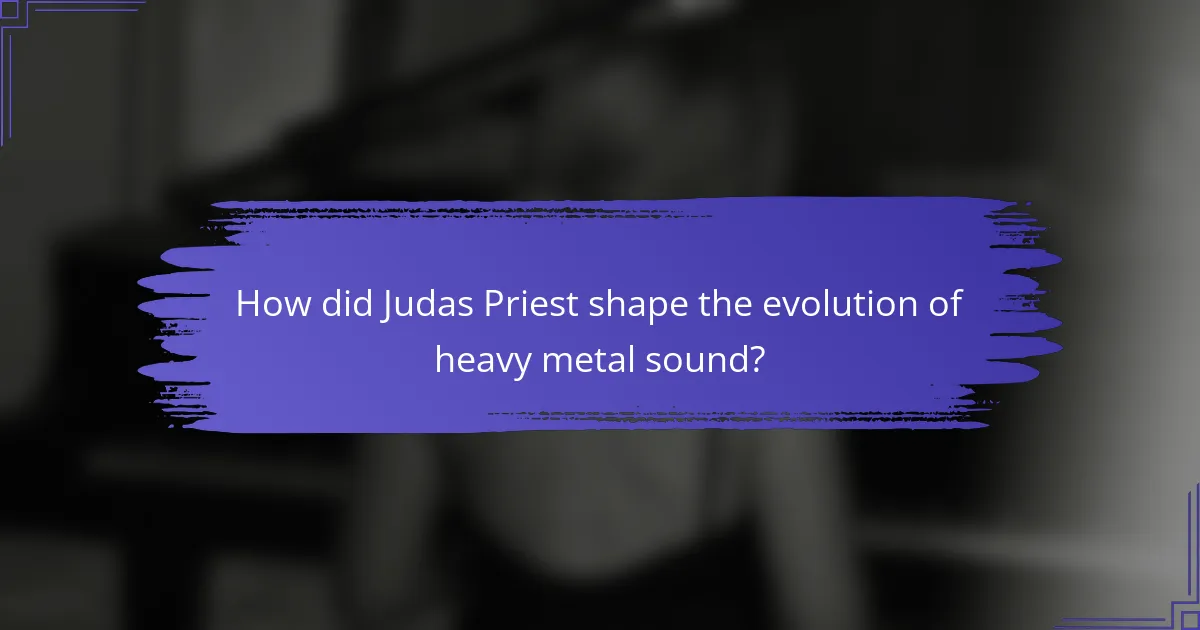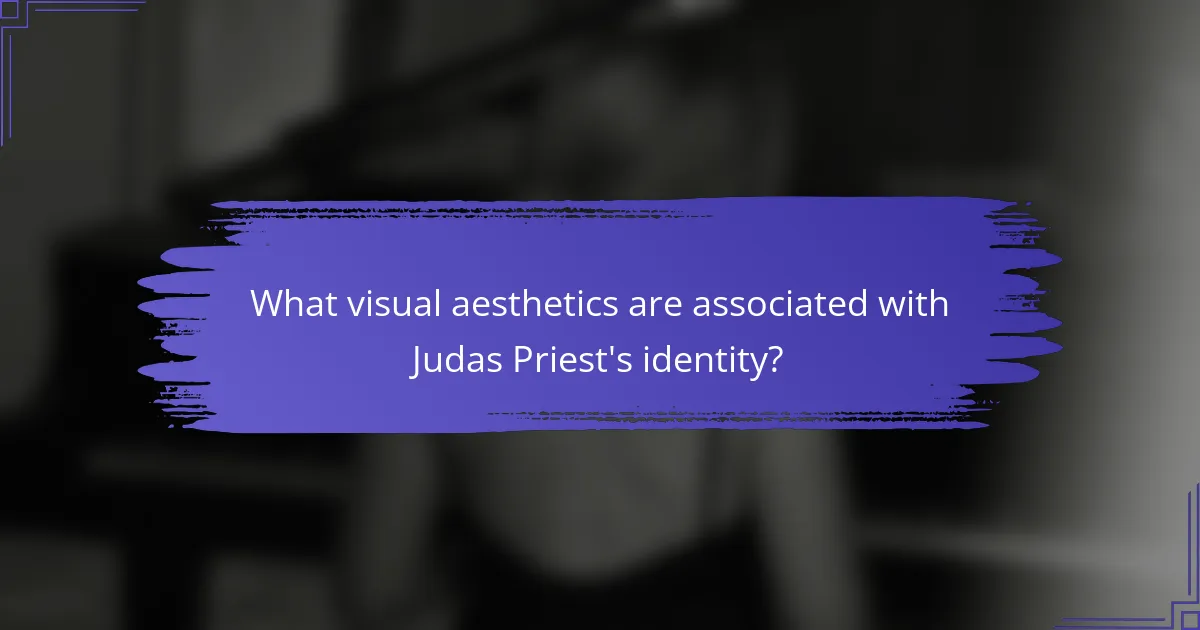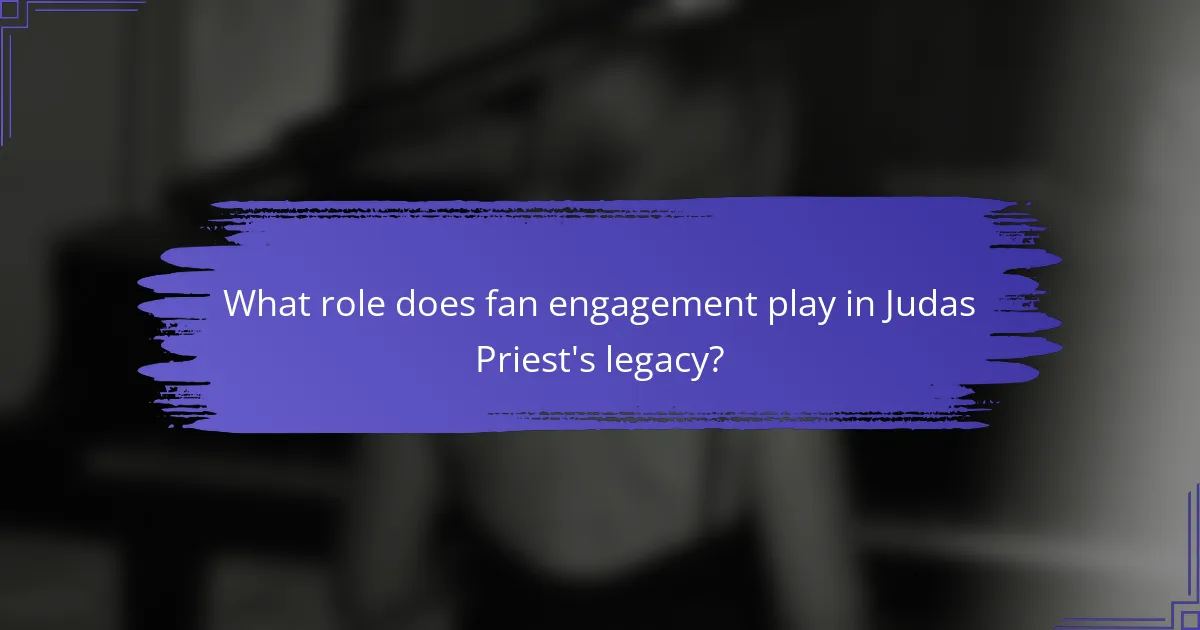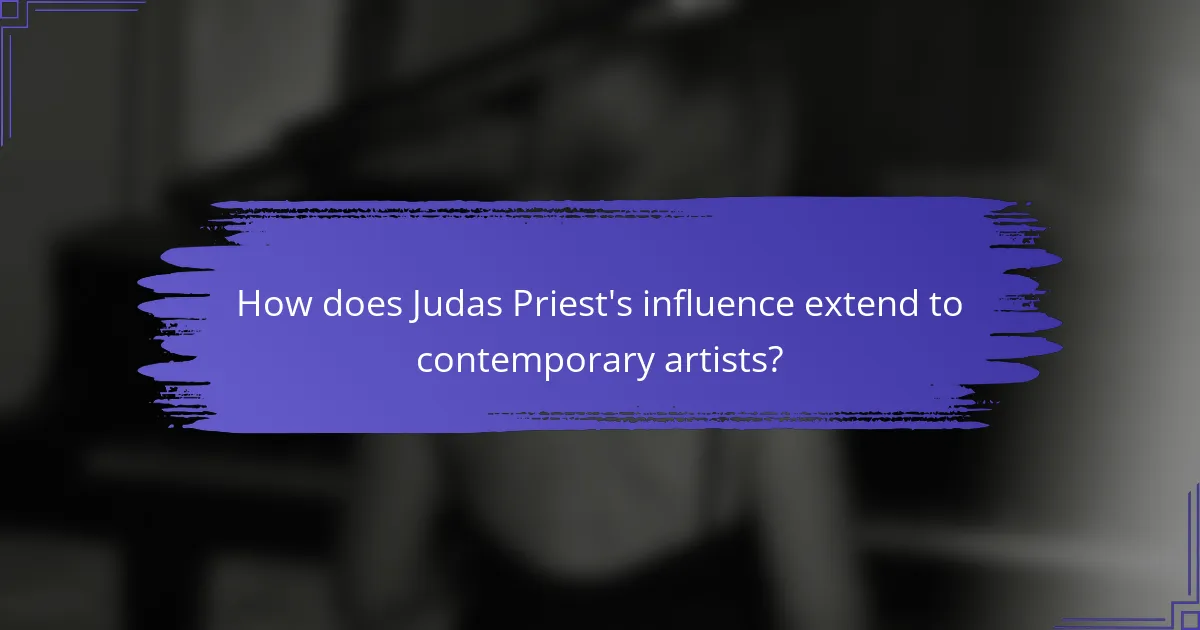Judas Priest has played a pivotal role in shaping heavy metal’s sound and aesthetics. Their innovative guitar harmonies and high-pitched vocals set genre standards. The band’s iconic leather-and-studs imagery symbolizes rebellion and power. Key themes in their lyrics explore personal struggle and escapism, while their career milestones highlight significant contributions to heavy metal history.

How did Judas Priest shape the evolution of heavy metal sound?
Judas Priest significantly influenced heavy metal sound by introducing a blend of melodic elements and aggressive guitar work. Their dual guitar harmonies and high-pitched vocals set a standard for the genre. The album “British Steel” showcased accessible songwriting, helping to define heavy metal aesthetics. Their leather-and-studs imagery became iconic, representing rebellion and power. The band’s evolution included experimentation with speed metal and progressive elements, which expanded the genre’s boundaries. These innovations solidified Judas Priest’s role as pioneers in heavy metal history.
What musical elements define Judas Priest’s signature style?
Judas Priest’s signature style is defined by aggressive guitar riffs, soaring vocals, and a blend of speed metal with traditional heavy metal. Their dual guitar harmonies create a distinctive sound that is both melodic and powerful. The use of leather and studs in their image reinforces the rebellious aesthetic of heavy metal. Unique attributes include their pioneering influence on the genre and the incorporation of elements from punk rock and progressive rock.
How did the band’s production techniques influence their sound?
Judas Priest’s production techniques significantly shaped their sound by emphasizing clarity and aggression. They utilized multi-layered guitar harmonies, creating a rich texture that defined heavy metal. Their collaboration with innovative producers allowed for experimentation with effects and studio techniques, enhancing their sonic depth. The use of reverb and delay added a dramatic flair, while precise mixing highlighted the dual guitar work, setting a standard for future metal bands.

What visual aesthetics are associated with Judas Priest’s identity?
Judas Priest’s identity is defined by bold visual aesthetics that include leather, spikes, and metallic elements. These features symbolize rebellion and power, reinforcing the heavy metal genre’s spirit. The band’s iconic stage presence often showcases elaborate costumes and dramatic lighting, enhancing their musical performance. Their imagery, including album covers and promotional art, frequently incorporates themes of fantasy and dystopia, creating a unique visual narrative that complements their sound.
How do stage performances reflect the band’s heavy metal ethos?
Stage performances reflect Judas Priest’s heavy metal ethos through theatricality, powerful imagery, and musical intensity. Their concerts often feature elaborate costumes and stage setups that embody the rebellious spirit of heavy metal. The band integrates dynamic lighting and pyrotechnics to enhance the experience, creating a visual representation of their sound. This alignment between performance and music reinforces their identity as pioneers of the genre.
Which fashion choices have become iconic within the heavy metal community?
Judas Priest has significantly influenced iconic fashion choices within the heavy metal community. Their leather jackets, studs, and spikes became symbols of rebellion and individuality. The band’s embrace of a bold, aggressive aesthetic helped define the visual identity of heavy metal. Additionally, their use of metallic colors and intricate designs in clothing sets them apart, making these elements rare attributes in the genre. Fans often adopt these styles, reflecting the band’s impact on heavy metal culture.

What are the key themes explored in Judas Priest’s lyrics?
Judas Priest’s lyrics explore themes of rebellion, personal struggle, and the quest for freedom. They often reflect the human experience through powerful storytelling and vivid imagery.
Key themes include:
1. **Rebellion against authority** – Many songs depict a challenge to societal norms.
2. **Personal struggle** – Lyrics often convey inner conflicts and resilience.
3. **Fantasy and escapism** – Imagery of mythical worlds and adventures is prevalent.
4. **Love and relationships** – Emotional narratives about love’s complexities appear frequently.
5. **Identity and self-discovery** – Exploration of one’s true self is a recurring motif.
These themes contribute to Judas Priest’s unique position in heavy metal, resonating with listeners through relatable experiences and powerful messages.
How do the band’s lyrics resonate with fans across different cultures?
Judas Priest’s lyrics resonate globally by expressing universal themes of struggle, freedom, and rebellion. These themes transcend cultural boundaries, allowing fans to connect emotionally, regardless of their background. The band’s unique storytelling style, combined with powerful imagery, enhances this connection. For example, tracks like “Breaking the Law” evoke feelings of defiance, appealing to diverse audiences. The rare attribute of their lyrical depth fosters a sense of belonging among fans, uniting them through shared experiences and emotions.
What storytelling techniques are prevalent in their songwriting?
Judas Priest employs vivid imagery, narrative arcs, and emotional depth in their songwriting. They often explore themes of rebellion, personal struggle, and dystopian futures. Their use of storytelling techniques enhances the listener’s experience and connection to the music. For example, songs like “Beyond the Realms of Death” tell a poignant story of existential conflict, while “Electric Eye” presents a cautionary tale about surveillance. This blend of storytelling with heavy metal aesthetics solidifies their unique place in the genre.

Which albums mark significant milestones in Judas Priest’s career?
Judas Priest’s career milestones include “Sad Wings of Destiny,” “British Steel,” “Screaming for Vengeance,” and “Painkiller.” Each album significantly shaped heavy metal’s aesthetics and sound.
“Sad Wings of Destiny” (1976) introduced progressive elements and dual guitar harmonies, setting a foundation for future metal. “British Steel” (1980) marked a commercial breakthrough, featuring iconic tracks like “Living After Midnight” and “Breaking the Law.” “Screaming for Vengeance” (1982) showcased a blend of melody and aggression, solidifying their presence in the genre. “Painkiller” (1990) revitalized the band’s sound with speed metal influences, establishing a new standard for heavy metal.
How did “British Steel” redefine the heavy metal genre?
British Steel redefined the heavy metal genre by introducing a more aggressive sound and visual style. Judas Priest played a pivotal role in this transformation with their dual guitar harmonies and leather-clad aesthetics. Their album “British Steel,” released in 1980, showcased streamlined songwriting and powerful riffs, influencing countless metal bands. The incorporation of themes like rebellion and freedom resonated with audiences, solidifying their impact on the genre’s identity.
What impact did “Painkiller” have on the metal scene in the 1990s?
“Painkiller” significantly shaped the metal scene in the 1990s by redefining heavy metal aesthetics and sound. Its aggressive riffs and high-pitched vocals set a new standard for speed metal. The album’s themes of pain and redemption resonated with fans, influencing many emerging bands. Additionally, “Painkiller” showcased Judas Priest’s unique attributes, such as intricate guitar solos and powerful lyrics, which became hallmarks of the genre. The album’s impact is evident in the way it inspired a wave of metal acts that followed, solidifying its legacy in heavy metal history.

What role does fan engagement play in Judas Priest’s legacy?
Fan engagement is crucial to Judas Priest’s legacy as it fosters a loyal community and enhances their cultural impact. The band’s ability to connect with fans through live performances and social media has solidified their status in heavy metal. This interaction strengthens their influence on emerging artists and keeps their music relevant across generations. Unique attributes, such as their iconic leather-and-studs aesthetic, resonate deeply with fans, creating a lasting bond that transcends mere musical appreciation.
How do fan interpretations of the band’s music vary by region?
Fan interpretations of Judas Priest’s music vary significantly by region due to cultural influences and local metal scenes. In Europe, fans often emphasize the band’s theatricality and lyrical depth, reflecting a strong tradition of heavy metal. In contrast, North American fans may focus more on the raw energy and guitar-driven sound, influenced by the hard rock roots of the genre.
In South America, interpretations often highlight the band’s rebellious themes, resonating with local struggles and societal issues. Asian fans might appreciate the technical musicianship, aligning with a broader appreciation for intricate musical compositions.
These regional differences showcase how Judas Priest’s music transcends borders, adapting to diverse cultural contexts while maintaining its core heavy metal identity.
What are the most memorable fan interactions with Judas Priest?
Judas Priest has had numerous memorable fan interactions that highlight their connection to audiences. Fans often share stories of attending concerts where the band engaged directly with them, such as Rob Halford riding a motorcycle on stage, creating an electric atmosphere. Another notable interaction occurred during their “British Steel” tour, where fans were invited to sing along, fostering a sense of community. Unique moments include Halford’s candid conversations with fans about personal struggles, showcasing the band’s relatability. Additionally, the band’s use of social media has allowed them to connect with a global fanbase, sharing behind-the-scenes content and responding to fan messages, further solidifying their legacy in heavy metal culture.

How does Judas Priest’s influence extend to contemporary artists?
Judas Priest’s influence on contemporary artists is profound, shaping heavy metal’s sound and aesthetics. Their pioneering use of twin guitar harmonies and leather-and-studs imagery set standards for the genre. Many modern metal bands, such as Avenged Sevenfold and Ghost, cite Judas Priest as a key inspiration. Their albums, especially “British Steel,” introduced mainstream accessibility to heavy metal, influencing artists across various genres. The band’s commitment to theatrical performances and lyrical themes of rebellion continues to resonate, ensuring their legacy endures in today’s music scene.
Which modern bands cite Judas Priest as a major influence?
Several modern bands cite Judas Priest as a major influence, including Metallica, Pantera, and Avenged Sevenfold. These bands have acknowledged Priest’s impact on their sound and style, particularly in heavy metal. Metallica often references Priest’s guitar work and dual lead harmonies. Pantera has noted Priest’s aggressive riffs as a key inspiration. Avenged Sevenfold incorporates similar melodic elements influenced by Priest’s music.
What aspects of their sound are echoed in today’s heavy metal?
Judas Priest’s sound, characterized by powerful guitar riffs and soaring vocals, heavily influences today’s heavy metal. Their twin guitar harmonies and aggressive drumming set a standard for the genre. The lyrical themes of rebellion and personal struggle resonate in contemporary metal. Additionally, their visual aesthetics, including leather and spikes, continue to shape metal culture. The band’s pioneering spirit in blending various rock styles has led to a diverse sound palette seen in modern heavy metal bands.
What best practices can musicians learn from Judas Priest’s career?
Musicians can learn the importance of innovation, consistency, and audience connection from Judas Priest’s career. Their commitment to evolving heavy metal aesthetics set a standard. They embraced new technologies and styles while maintaining their core sound, demonstrating adaptability. Engaging with fans through live performances and merchandise fostered a loyal community. Their iconic imagery and branding reinforced their identity, showing the power of visual elements in music. Finally, collaboration with other artists expanded their reach, illustrating the value of networking in the industry.



